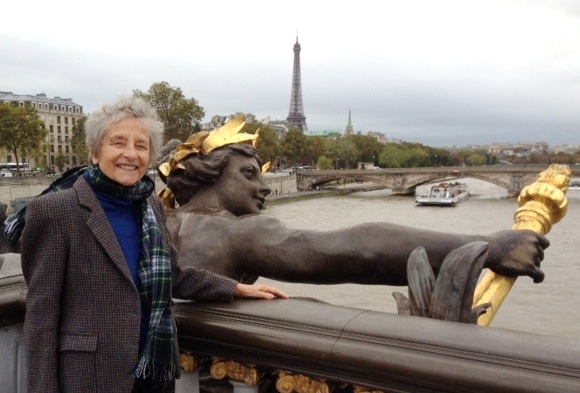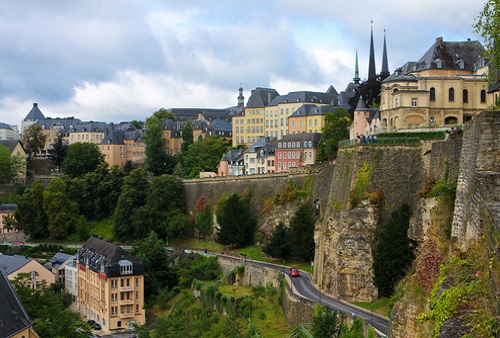
Although Luxembourg is a minuscule country, with only 476,000 inhabitants, it is one of the world banking powerhouses occupying second place with 2.4 trillion euros under its management. It is one of the founding members of the European Union (EU) and has been an active participant at every step of its construction. How did this happen?
The capital occupies a spectacular site on a rocky ridge overlooking the precipitous ravines of the Petrusse and Alzette rivers. From the Roman streets (Cardo and Decumanus) intersecting in the Marchė aux Poissons (fish market) to the all-glass museum of contemporary art designed by I. M. Pei, a visitor to Luxembourg can admire many periods of architecture including the ducal palace built in a rare 15th century Spanish-Moorish style.

After centuries of domination by neighbors, including France, the Netherlands and Belgium, the 1839 Treaty of London granted the Grand Duchy of Luxembourg both its independence and definitive borders. Grand Duke Henri is the incumbent ruler of the reigning Nassau-Weilbourg dynasty .
The vocation of Luxembourg was at first to be an impregnable fortress. In 963, Count Sigefroi chose the rock of Bock to build a fort. When, in 1684, Napoleon laid siege to the town, he turned to his renowned military architect Vauban to expand the fortifications, which are still visible today, with ramparts, towers, tunnels, bastions and casemates (military blockhouses), all dug out of the cliffs.
Luxembourg has also enjoyed another vocation — to be chosen sometimes as the ruler of Europe. In 1308, Count Henry VII was elected King of Germany by the Prince Electors and soon afterward crowned as head of the German Holy Roman Empire. Since December 2014, the EU President – its highest executive – is Jean Claude Juncker, former Prime Minister of Luxembourg.
Luxembourg has been closely associated with the process of unification of Europe. Robert Schuman, born of a French father and a Luxembourg mother, was among the founding fathers of Europe. In 1947, the BENELUX convention, which created a customs union, was signed between Belgium, the Netherlands and Luxembourg. In 1950, Schuman and Jean Monet from France created the ECSC (European Coal and Steel Community). In 1957, Luxembourg, France, Germany, Italy, the Netherlands, and Belgium signed the Treaty of Rome, creating the EEC (European Economic Community).
The 1985 “Schengen Space” agreement, abolishing borders within Europe, took its name from a small Luxembourg village. The ‘quartier européeen’ has sprung up as a small Manhattan on the Kirchberg plateau with the sky scrapers of the European institutions like the European Investment Bank, the European Court of Justice, and most of the 150 international banks emblematic of modern Luxembourg.
In the 19th century, the discovery of iron ore brought Luxembourg into the industrial age. On the eve of World War I, it was the sixth producer of steel in the world. But, with the decline of steel metallurgy after the 1970s, Luxembourg had to reinvent itself and turned toward financial activities, which today constitute more than 30 percent of the country’s GDP. In 2001 the “Clearstream” scandal raised the suspicion of tax evasion.
Currently the trend is toward increasing transparency in the banking business. In early March of this year, during an official visit to Luxembourg by French president Hollande, “tax optimization” was discussed. It was decided that, by 2017, the exchange of information will become automatic between the two countries.
The policy of Brussels, led by Juncker, is to launch a program of “quantitative easing” or QE (similar to the one carried by the Federal Reserve in the US), of 3,000 billion into the European economy. Countries are now scrambling to qualify for the bail-out funds by presenting their most innovative projects.

About the author: Nicole Prévost Logan divides her time between Essex and Paris, spending summers in the former and winters in the latter. She writes a regular column for us from her Paris home where her topics will include politics, economy, social unrest — mostly in France — but also in other European countries. She also covers a variety of art exhibits and the performing arts in Europe. Logan is the author of ‘Forever on the Road: A Franco-American Family’s Thirty Years in the Foreign Service,’ an autobiography of her life as the wife of an overseas diplomat, who lived in 10 foreign countries on three continents. Her experiences during her foreign service life included being in Lebanon when civil war erupted, excavating a medieval city in Moscow and spending a week under house arrest in Guinea.